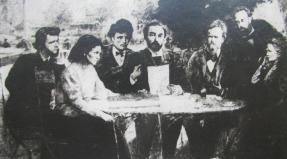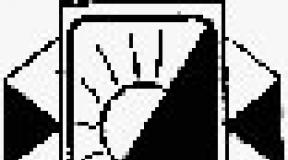How much air do you breathe? About real air exchange in a cottage How much air does a person inhale per minute?
Where does the heat go in the house? Where does it go in winter when it’s cold and where does it come from in summer when it’s hot? Part of the heat goes to heating the AIR.
It remains to remember such a small detail, in fact, for the sake of which the house is being built - these are the residents. For people to live, they need fresh air, which must be renewed. How many cubic meters of air should be renewed in the house per hour? How many cubes are actually updated per hour in the room where you are now? There is no single answer to this question.
Formally, in accordance with Soviet-era SNiP, three cubic meters per hour per square meter, in other words, in an ordinary room with a ceiling height of 2.5 - 3 meters, the air should be renewed once per hour! Do you always need fresh air?
No not always. In rooms where there are no people and no technological processes consuming air, air exchange is not needed at all. Why is there air exchange there? In the house in conservation mode (at low temperatures) it is generally harmful! With new (fresh) air, rooms can become filled with unnecessary moisture and dust.
How much air does a person need to breathe? “Adults, at rest, produce an average of 16 to 20 respiratory movements per minute. The volume of each breath is usually about 500 ml, hence the minute volume of breathing is 500 * 16 = 8000 ml. In a newborn, the respiratory rate is 60-70 breaths per minute, by 5 years it decreases to 26, and by 15-20 years, to 20 per minute. During work, movement, and fever (in conditions of increased metabolism), the number of respiratory movements per minute increases. Ventilation of the lungs, equal to an average of 8 liters at rest, increases 20 times during heavy physical labor.” Since at home they rarely do heavy physical work, and if they do, they sometimes open the windows wide, not even for breathing, but to cool down. We will assume that at home the breathing norm can be exceeded, say 3-4 times. So one person uses approximately 2 m3 of air per hour. Since fresh air is mixed with old air in an unclear ratio, let’s assume that 20% of the air in the cube is renewed, which means that one person needs (even with a fourfold supply) 10 m3 of air per hour. Logic dictates that the intensity of air exchange should depend not on the volume of the room (once per hour), but on the number of people in this room. A living room with one occupant is one thing; for example, a classroom in which more than 30 people are constantly present is another thing. In a bedroom with a volume of 30 m3, a change of 10 m3/hour is sufficient - this is 1/3 of the air change in the room. And in a crowded classroom, 130 m3 and twice the air exchange per hour will not be enough - 30 people need 300 m3 of air. Engineering companies successfully speculate on similar considerations, imposing powerful ventilation and expensive energy recovery (energy-saving) installations on naive cottage owners.
How many square meters of house do you have? - 600. - 600? Great... 600m2 area *3m height = 1800m3 air. You need to replace 1800 cubic meters of air in an hour according to the requirements of SNiP - no less! This means that in winter (-20 C) 24 kW/hour or 576 kW per day will be spent on heating such a volume of air per hour. - Almost 600 kW per day!!! However…. - Well, you don’t want to suffocate, do you? - Of course not! - Moreover, note that we are not inventing anything, SNiP is an official document. Now you understand how urgently you need a recovery system that will save you up to 60% of these energy costs, because the exhaust air (thrown out into the street) will transfer some of the heat to fresh air, having preheated it! Great?! - Great…
And this is said at a time when such a volume of air is actually enough for comfortable breathing of 180 people! And in that house only 4-6 people will live (including servants). And during the “banquet”, opening the windows is not a problem. Change the air once per hour!!! While the supply of breathing air in the house is 600 m2, such that if the whole family breathes continuously, it can be “breathed” only in two days - 45 hours. When the peat bogs were burning, a friend of mine did just that: during strong smoke, he battened down all the windows and calmly breathed the air stored in the house (1200 m2 with 3.5 m ceilings) without harm to his health for a whole week.
What kind of air exchange occurs in our apartments?
In an ordinary apartment of 80 m2 with a ceiling height of 2.65 m, the volume of the premises is 200 m3. There are 14 such apartments connected to a common ventilation duct, and in other buildings there are 16 or 22. If we assume that in all apartments there is an air exchange once per hour, then 2800 m3 of air should come out of the ventilation riser per hour, in the case of a ventilation shaft With a cross section of 0.24 m2, this air forms a column 11.6 km high. This means that the air from the ventilation duct should exit at a speed of 11.6 km/h or 3.2 m/sec! I climbed onto the roof - the air duct is in perfect order (not blocked, as is usually the case), everyone lives in the apartments and does not spare air. There is no such flow there, not even a trace!
So what kind of air exchange should there really be in a cottage, because we are considering exactly this case. If there is no or little environmentally harmful fumes from objects or other negative factors affecting air quality in the house, then the flow of fresh air (renewal) per person, even with a reserve, should be approximately 10 m3/hour. This means for a family (5 people) it will be 50 m3/hour, and what difference does it make where this family lives??? One family lives in a small apartment of 50 m2 with ceilings of 2.5 m, and another family lives in a palace of 1000 m2 with ceilings of 3.5 m, and according to SNiPs it turns out that 3500 m3 of air in the palace needs to be changed every hour??? Is it that because the family lives in the palace, they will breathe 70 times more?! Obvious absurdity! Such people breathe no more than ordinary citizens - I saw it myself. Otherwise, to blow (ventilate) the palace, it would be necessary to borrow a turbine from the wind tunnel in Zhukovsky, while everyone knows that palaces have always managed without turbines and fans since ancient times. Problem in the concept...
It is necessary to note such a detail (which the sellers of these systems modestly keep silent about) that only clean, dry air, free of dust and grease, is subject to recovery - air from ordinary residential premises, but in no case air contaminated with oils and fats, air enriched with moisture from kitchen hoods, bathrooms, saunas and toilets. Although, following the logic of energy saving, it is from such air that heat must be removed first.
What are you saying, we don’t need that kind of air! He immediately clogs all our filters, all our ventilation ducts, all our equipment and sensors with dirt, grease and moisture! Our recuperator is not designed for this, and every other day we will have to disassemble it for maintenance! What are you, what are you...
Let's look at the principle by which air is replaced in the house and follow the algorithm of its movement. Through a window or a crack in the window, fresh, clean, I’d like to think so, air enters the room. Then, slightly used, it gets deeper into the house: into the corridor or onto the stairs - there it deteriorates even more. In the end, it is drawn into one of the rooms where it completely deteriorates - into the bathroom, where (well, you understand...) either into the bathroom, where it is saturated with moisture, or into the kitchen, where it is saturated with smoke-grease from the stove, or steam from the soup and only then is it mercilessly thrown out. This is exactly the kind of dirty, humid and greasy air that recuperators are afraid of (I understand them perfectly well). Everyone knows what a ventilation grill clogged with dirt looks like. How much dirt is in the exhaust duct in the kitchen or bathroom? Horror! Have you ever cleaned this ventilation? Many people don't even know about its existence! And the recuperator filters seem to be cleaned!
Why then do we need recuperators at all?
The recovery system is, of course, a good and necessary thing for rooms crowded with people - for offices, for shopping centers and so on... But we don’t need it in the cottage. This is not a matter of economics or heat loss. The point here is that we are talking about a country residential building. These words COUNTRY and RESIDENTIAL contain a lot of meaning. There is a very big difference in the approaches and ideology of designing a city multi-storey building from, for example, a concrete monolith, or an office center, or a hypermarket, or a factory, or a warehouse complex, and... just a country residential building.
Any air duct system involves taking air from outside. To prevent birds, rats and other living creatures from flying into the air ducts, at least a large mesh is placed at the entrance. To prevent flies, wasps and mosquitoes from flying in, a finer mesh is installed, to prevent poplar fluff and dust from flying in (including during the spring flowering of trees), a filter made of corrugated paper is installed - like a cabin filter in a car. In any vent. the system (no matter with or without a recuperator) needs a filter - otherwise all the air ducts will become dirty very quickly! This is a fact... Filtration in any ventilation system containing a network of ventilation ducts is done not for the sake of benefit or harm to humans, but for the sake of the normal (from a technical point of view) functioning of the system itself. It is necessary by definition!
Living in nature, in the countryside, I don’t want to breathe the air that comes into my room through a system of metal or plastic air ducts! I want fresh air to come to me directly - through the window in the window! You see, this is as wild and abnormal as coming to a lake or river and cooking fish soup from canned fish! Because if the air is not first filtered, then all the air ducts will become clogged with dust and dirt and become populated with mice, microbes and generally unknown things - the plot of the movie “Gremlins” was even based on this. And if you filter it, you get this: for example, now there is dust or some other pollutant in the air on the street (let’s say that a convoy of Kamaz trucks passed to a neighbor’s construction site) - the air passed through the filter (like a cabin filter in a car) and from this dust - the burning soot was cleared. The air has become cleaner - bravo! But the filter has become dirtier! All this dust, fumes and soot settled on the filter. The dirty days or hours (or minutes) have passed, and the air outside the window has again become as clean as a tear, but it enters the house through the same filter, already polluted by the old dirty air. Thus, a shock dose of dirt once falling on the filter is constantly injected with new - crystal clean air into your room! It is no longer injected in the form of coarse dust and fumes, but at a qualitatively different level - the molecular and ionic level! That is, until you replace the filter with a new one, even in the presence of the cleanest air, you will breathe the composition that the Kamaz trucks that concreted the basement for your neighbor left you, maybe even six months ago! That is, dirt, once in the air and getting into your filter, is stubbornly... PERSISTENTLY forced into your lungs by the ventilation system, decomposing over time from mechanical influences (vibration of fans) into small (more dangerous to health) fractions and components that leave their temporary shelter-filter and move on. If you want to breathe dirty air, you can’t come up with anything special: create a device for processing coarse dirt into smaller dirt, in order to better assimilate it! A godsend for a terrorist who wants to harass you is to throw a broken mercury thermometer from a pharmacy into your air intake - all the mercury is guaranteed to end up in the house! I'm not even talking about the colonies of deadly bacteria that may become new residents in the ventilation ducts. Man himself created a new habitat - wait for guests! Someone will definitely live there: “a holy place is never empty.” That's what it's all about!
How does it usually happen...? Kamaz trucks went outside, closed the windows, and sat for a while in cramped conditions. The Kamaz trucks have passed - you have opened the windows and are breathing fresh air. Even if dirt gets into the room, the air is purified by settling, over time all the dirt will settle in the form of dust in the room, and the air will be clean! (Dust is dealt with using wet cleaning.)
Air passed through filters and ventilation ducts that cannot be cleaned is environmentally harmful air! Air passed through a dense filter (like for the combustion chamber of an engine in a car) will change its ionic structure and becomes DEAD AIR, which is only useful for burning fuel in an internal combustion engine! We live not in a bomb shelter, but in a DACHA!
Based on this logic, I recommend making supply ventilation in the form of separate channels through the wall or through valves in the windows. Cold winter air tends to fall and spread across the floor (cold air is heavier). In this case, heated ceramic floors will serve as an effective heater for fresh supply air! Of course, you need exhaust ventilation from every room, and not just from the kitchen-bathroom-toilet. As for what will be in the ventilation ducts for exhaust air, I am deeply indifferent (they need to be, if possible, without horizontal sections).
But so that the volume of air flowing through the house is not huge and does not blow out all the heat in winter, you need to build a house from environmentally friendly materials so that no one else but people spoils the air in the house. All of the above can be compared to the air emitted by a vacuum cleaner - the principle is the same, only the vacuum cleaner sucks in more dirt than the ventilation system, and from a health point of view, a bad vacuum cleaner is more harmful than dirt on the floor. While the dirt was on the floor, it created purely aesthetic discomfort, and when the dirt was moved with a vacuum cleaner (mud mixer) and thrown into the room with a stream of air, it began to be inhaled by people, and became truly dangerous, since it ended up not in the corner under the sofa, but in our lungs! Therefore, for those who are allergic to dust or asthma, cleaning an apartment with a bad vacuum cleaner is like death! This is why they are trying to improve vacuum cleaners - they clean the air by passing it through water vortices and so on. A ventilation system with air ducts is the same as a vacuum cleaner! Who wants to breathe the air from a vacuum cleaner?
A SEA OF HANDS... What's really going on with our air conditioners? You come to people - their air conditioner is completely black with dirt! As it was installed 10 years ago, no one has touched it since then... it’s not like co-profits... from there the tubercle sticks make faces at you and stick out their tongues... but the people do nothing... they sit and work all day long . -Are you okay? - Yeah, everything is OK with us! Nobody is complaining...
So what kind of air exchange actually occurs in the cottage?
If there are no environmentally harmful fumes from finishing materials or radon from the basement, in a house of any size the real air exchange will be: for human breathing 50 m3 and for technological needs, well, another 100 m3. A total of 150 cubic meters of fresh air per hour is enough! In the Piros project, for example, the volume of rooms inside the house is 450 m3, which means that only 1/3 air change per hour is enough (three times less than according to SNiP requirements). To heat 150 m3 of cubic air at 40 degrees C, you need 2 kW/hour or 48 kW per day.
This already looks like the truth. We can assume that a 2 kW fan heater is constantly working to heat the supply air. This is exactly why, in order to ensure that there are no drafts in the room from open vents, you need not only exhaust ventilation, but also supply ventilation. You need air that is preheated and purified from dust, and, if necessary (in case of forest or peat fires), also from smoke using an additional carbon filter. But you shouldn’t get carried away with forced ventilation... The air that passes through the filters changes its ionic composition and is healthy - it ceases to be “fresh” - it (like distilled water for drinking) is no longer suitable for breathing.
Summary: the actual air exchange in a cottage is significantly lower than SNiP standards and does not depend on the volume of its premises. Provided that it is not a company of soldiers living there, but a family of 4-6 people, the ventilation volume is a couple of hundred cubic meters of fresh (supply) air per hour. In this case, the recovery system for the cottage does not justify itself, especially considering that it is not capable of processing humid air contaminated with fats, oils and dust. However, why can’t she? A couple of months is possible... until the first repair...
It is very useful to have a supply ventilation system without horizontal sections with the possibility of preheating and purifying air for use in emergency situations (smoke - forest fires, etc.), but you should not get carried away with purified air. Purified air is good for a carburetor or injection system in a car, but not for human breathing. (I’m not talking about the exhaust ventilation system, as it is an obvious thing.) Let’s not forget about the supply ventilation for an open fireplace or stove, if any.
For athletes, especially swimmers, it is much higher - up to 6-7 liters. However, even after the deepest exhalation, another 1-1.5 liters of so-called residual air remain in the lungs. Even in a corpse, this air remains in the lungs, which explains the low specific gravity of this organ. That is why the name “lungs” arose. If a person has taken at least one breath in life, the residual air takes its place, and a piece of lung thrown into the water floats up. This is important in forensic medicine, because it allows you to determine whether the child was stillborn or died after birth.
During normal quiet breathing, a person inhales 500 ml of air. However, only about 350 ml reaches the alveoli. The remaining 150 ml of air fills the airways. This means that only 1/7 of the 3 liters of air contained in the lungs is renewed. In other words, the alveolar air is only diluted with fresh air, and not completely renewed. This makes sense: the blood flowing to the alveoli always comes into contact with air of approximately the same composition.
With 16 breaths per minute, a person makes more than 23 thousand respiratory movements per day, and over 7 thousand liters of air pass through the lungs. Muscular work causes faster and deeper breathing. If at rest pulmonary ventilation per minute is 5-6 liters, then in well-trained athletes it can reach 140 liters when running at medium distances, i.e. it increases more than 5 times more than the minute volume of blood circulation.
The volume of air inhaled (exhaled) by a person
The amount of air consumed by an adult and a child when inhaling (exhaling)
Only with very strong physical exertion are we able to increase the inhaled (exhaled) volume of air four times (i.e., up to 2/3 of three liters), thus obtaining two-thirds of the normal lung volume (2 liters - vital capacity of the lungs - vital capacity) ). In the same way, with a strong exhalation, a person can exhale an additional 1.5 liters of half a liter - the reserve volume. The maximum volume or total capacity of the lungs may exceed 3 liters. For some it reaches 5 or more liters (for example, trained athletes, athletes, etc.).
Minute and daily volume, taking into account different physical states of the body
So how much air does a person inhale and exhale per day? On average, we pass through our lungs 15 - 20 cubic meters of air per day, and approximately 6,000 cubic meters per year. meters. During the longest life, a person is not able to use half a cubic kilometer of inhaled air.
Calculation of human need for fresh air
Diary entry created by Andrey-AA, 09/12/10
However. These data are taken for the case of carbon dioxide carryover from humans, i.e. as if in the fresh air, and therefore these figures have nothing to do with calculations for ventilation of premises.
I came up with an approach that will help determine the ventilation needs of homes, because I don’t trust SNiPs and sellers of happiness.
Briefly: oxygen is a useful gas, CO2 is harmful. It is necessary to determine for each of them, calculate the need for ventilation (cubic meters of air per hour per person), and then select the maximum figure from the two. This will be a reasonable figure for air exchange in homes.
I found this method in this article:
“If you do a little calculation, you find out the following.
For example, in a room of 33 m3, there are 10 people. 10 people exhale approximately (10X25) 250 liters of carbon dioxide per hour. As a result, the level of carbon dioxide will double in 21 minutes, and the level of oxygen will drop by a fraction of a percent over the same period of time."
"In our country, research on the effect of carbon dioxide on humans was carried out back in the 60s. O.V. Eliseeva, who used the methods of pneumography, rheovasography and electroencephalography, in the article “On the justification of the maximum permissible concentration of carbon dioxide in the air” in the journal Hygiene and Sanitation . – 1964. – No. 8., came to the following conclusions:
- Short-term inhalation of carbon dioxide in concentrations of 0.5 and 0.1% by healthy people causes distinct changes in the function of external respiration, blood circulation and electrical activity of the brain.
- Changes in these functions are more pronounced under the influence of CO2 at a concentration of 0.5%.
- The data obtained allow us to conclude that the CO2 concentration in the air of residential and public buildings should not exceed 0.1%, regardless of the source, and the average CO2 content should not exceed 0.05%.
If you believe this article, then on average a person exhales 25 liters of CO2 per hour, and its concentration should not exceed 0.1% (in nature - 0.04%). At rest - 15 liters of CO2 per hour.
Let's assume that in a dream - 10 liters of CO2 per hour, and in an active state - 30 liters / hour (small, domestic activity).
Let's try to figure out from here the need for ventilation while sleeping indoors.
Let's assume we have a sealed room - 20 square meters. meters (= 50 cubic meters). If, for example, it is well ventilated before going to bed, the CO2 concentration will be 0.04%. After 8 hours of sleep, a person will exhale 0.08 cubic meters of CO2, which is 0.16%, and in the morning there will be 0.2% CO2 in the room (0.16% + 0.04%), which exceeds the permissible value 2 times, but presumably not fatal.
That is, during sleep, air exchange should be no less than 50/8 = 6.25 cubic meters per hour. And for healthy sleep - approximately 15 cubic meters per hour.
Let's determine the need for CO2 ventilation during wakefulness (exhalation - 30 liters of CO2 per hour).
With a room volume of 50 m3, an hour of breathing will add 0.06% to the CO2 concentration. In total with the initial concentration (0.04% + 0.06%) - 0.1%. Those. There will only be enough fresh air for an hour.
Thus (in terms of CO2), air exchange during active home activity should be 50 cubic meters per hour per person (with a maximum CO2 content of 0.1%, since the average “hospital” value is not suitable here).
You probably need to look for and buy a CO2 meter and slowly figure out what’s going on in the apartment and at the dacha.
For example, Smart-2C02 (thanks for the tip - Master Master). A little expensive, really.
Found and added later:
Comments
More posts from Andrey-AA
about the author
Diary statistics
When using materials from the dacha forum in full or in part, an active direct link is required
- How many liters of oxygen does a person consume per day?
- How to get rid of acne on the eye
- How to take vitamins: simple rules for taking them
The amount of oxygen consumed by a person
If a person stands under the stream of a cold or fairly cool shower, the amount of oxygen he consumes will increase by almost 100%, and the release of carbon dioxide will increase by 150% (compared to conditions at room temperature). Consequently, the increase in the frequency of respiratory processes is influenced by an increase in human heat loss.
Human lung capacity
The capacity of a person’s lungs is significantly influenced by the activity of his respiratory processes. The lung capacity of athletes exceeds the norm by 1-1.5 liters, and the lung capacity of professional swimmers can reach 6 liters. Accordingly, an increase in lung capacity reduces the respiratory rate and increases the depth of inspiration.
How long will one cubic meter of air last for a person?
How long will 1 m³ of air last for an adult without dying or suffocating?
The time for which one cubic meter of air is enough for a person depends on many factors, in particular:
- air temperature and humidity. If the air is colder, it contains more oxygen;
- on the physical parameters of a person. All people are different, and therefore have different lung volumes;
- frequency of breaths. The less often you inhale, the longer the air will last;
- physical condition of a person. The most ideal option is to lie quietly and not move;
- emotional and psychological state of a person. In a state of calm, air consumption will be less.
On average, a person inhales liters of air per minute. If you calculate the maximum, that is, 10 liters of air per minute, then 1000 liters will be enough for 100 minutes. One should also take into account the fact that the exhaled air contains carbon dioxide, so we count the amount of inhaled air to the maximum.
There is an interesting film on the topic of the issue called “Buried Alive”.
By the way, when I read the question I immediately remembered the famous song “Breathing”:
One cubic meter of air can last indefinitely if you install an air regeneration unit.
Or another option is possible: pump compressed air with a high degree of compression into a container with a volume of one cubic meter and use it autonomously - this will also last for a long time. And if you also limit physical activity, the need for oxygen will decrease significantly.
In any case, the “survival time” under such conditions will increase significantly.
So it is simply impossible to say specifically that such and such an amount of air will be enough for such and such an amount of time, unless certain conditions of use are highlighted.
if we focus on normal life and focus on the current regulatory documents of the Russian Federation, then one person needs 60 m3/h (without the possibility of natural ventilation) - THEN 1 m3 is enough for one minute.
If a person plays sports (80m3/h), then less than a minute is 40 seconds.
But people are different in weight and therefore this is an average norm.
A person needs not air but oxygen; the air may initially contain a large percentage of carbon dioxide; such air will last for less time than air with a low carbon dioxide content. On average, a person needs 360 l/day for life, that’s 0.36 cubic meters, but I don’t think it’s 1 cubic meter in a confined space. enough for 2 days, perhaps a maximum of a day, since with each breath the amount of oxygen will decrease and carbon dioxide will increase
it all depends on the volume of a person’s lungs and how often he inhales air, that is, on the characteristics of his body and also on the state in which the person is in motion or at rest - on average, about 1 to 2 hours
..how many liters of air does a person need per day?
Also, the norms for shelters (without ventilation, i.e., boxes) are 2 cubic meters per person per hour per day.
So, if I understood your question correctly, then 8.6-16.0 cubic meters will be pumped through a person’s lungs per day. m of air (if it was not plowed).
If a person sits in an unventilated room, then this is a completely different problem, also easily solved. In its standard form, the formula for people staying in a closed chamber without ventilation usually determines the time they can sit there, and has the following form:
T=[(V-0.08*n)*(Kd-K)]:M*n (oh, it’s awkward to write formulas in mail) . Here T is the permissible time of stay in the chamber, hour. , V - volume of the chamber, l, n - number of people in the chamber, Kd - permissible concentration of carbon dioxide, l/l, K - initial concentration of carbon dioxide before closing the chamber, l/l, M - average release of carbon dioxide by one person in the chamber , l/hour. Since we are faced with another task - to determine the required volume of the chamber for a known time spent in it, we will transform this formula and obtain:
You wrote that the required time is one day, which means T=24; The release of carbon dioxide, if a person sits there for a day and is not preparing for a boxing match for the world champion title, I think can be taken as the daily average, that is, 30 l/hour (if more, substitute the necessary one; less is unlikely). Kd, that is, the permissible concentration of carbon dioxide. There is a lot of room for imagination here. Who is sitting - young healthy people or sickly and frail people? Children? Old men? In general, if the regime is gentle, then this value cannot be increased above 0.5%, and if young healthy people who can tolerate a possible mild headache jokingly, then nothing terrible will happen at 1% per day. Yes, by the way, you write about hypoxia, so this is precisely the lack of oxygen, oxygen starvation. We calculate using carbon dioxide, so a possible unpleasant condition will be called hypercopnia, that is, excess CO2.
So, we take Kd in the range of 0.005-0.01, that is, from half a percent to one percent. Well, K knows that if the air is not polluted, then it is 0.03%, that is, 0.0003.
If we substitute and round, we will end up with the required volume of the chamber for one person in dodoliters, or from 72 to 144 cubic meters. The difference, naturally, is due to the fact that we considered the permissible concentration to be within 0.5-1%. In a volume of 72 cubic meters per day, one organism will inhale approximately up to one percent, up to half a percent.
In general, I want to say that it is better to carry out such experiments with gas analyzers for oxygen and carbon dioxide in the chamber. If it is difficult to get equipment, you can at least buy glass tubes for express analysis and do it every hour. The fact is that sometimes you come across individual individuals who consume oxygen (and, accordingly, release carbon dioxide) in very large quantities. For example, we have one of these (I work on the Mir submersibles), his gas exchange is approximately twice as high as that of normal people. Further, smoking is strictly forbidden in this volume, and if you imprison a smoker, it is better for him to abstain from smoking for a day, otherwise he will inhale carbon monoxide, and this is worse than CO2. Well, the best thing, of course, is to organize some kind of simple life support system in a closed space. Then even if you sat in three cubic meters for a week, you would have something to drink and eat.
How much does the air we breathe in a day weigh?
Is it true that the air you breathe in is heavier than the food you eat during the day?
No matter how surprising and supernatural such a statement may sound, it is true. On average, a person eats no more than 3 kilograms of solid and liquid food per day, if it is weighed. Calculating the weight of inhaled air is also not difficult.
And so we calculate how many liters of air a person inhales per day. In one minute, you and I take about 15 breaths.
At the same time, each of our breaths introduces almost 0.5 liters of air into the lungs. Thus, a person inhales approximately liters of air per day! At standard pressure, such a volume of air will weigh about 14 kilograms, which is more than 4 times more than the food we eat per day. Did you think that air weighs nothing?
2 thoughts on “How much does the air we breathe in a day weigh”
The angle of incidence is equal to the angle of reflection, if you are so smart, remove the dust that has settled in your lungs and get the answer.
How much air do we inhale?
The vital capacity of the lungs is about 3 liters. Do we really breathe in and out so much air every time?
If you take the deepest possible breath, and then exhale as completely as possible, then 3 or even 4 liters of air will come out of your lungs. This is an indicator of the vital capacity of your lungs. Athletes with a trained respiratory system (especially swimmers) have an even larger lung capacity. They can hold up to 6-7 liters of air. But in a normal situation - not in one breath.
During quiet breathing, any person inhales about 500 ml of air. Approximately 150 ml fills the airways. This means that no more than 350 ml reaches the lungs. And in one exhalation you remove approximately the same amount of waste air from them.
Divide your vital capacity (3 L, or 3000 ml) by 350 ml.
It turns out that you renew the entire volume of air contained in the lungs in 8 inhalations and exhalations.
Research methods and indicators of external respiration
Methods for studying functions and indicators of external respiration
The entire complex process of breathing can be divided into three main stages: external breathing; transport of gases by blood and internal (tissue) respiration.
External respiration is the exchange of gases between the body and the surrounding atmospheric air. External respiration involves the exchange of gases between atmospheric and alveolar air, as well as gas exchange between the blood of the pulmonary capillaries and the alveolar air.
This breathing occurs as a result of periodic changes in the volume of the chest cavity. An increase in its volume provides inhalation (inspiration), a decrease - exhalation (expiration). The phases of inhalation and subsequent exhalation constitute the respiratory cycle. During inhalation, atmospheric air enters the lungs through the airways, and when exhaling, some of the air leaves them.
Conditions necessary for external respiration:
- chest tightness;
- free communication of the lungs with the surrounding external environment;
- elasticity of lung tissue.
An adult takes breaths per minute. The breathing of physically trained people is rarer (up to 8-12 breaths per minute) and deeper.
The most common methods for studying external respiration
Methods for assessing respiratory function of the lungs:
- Pneumography
- Spirometry
- Spirography
- Pneumotachometry
- Radiography
- X-ray computed tomography
- Ultrasonography
- Magnetic resonance imaging
- Bronchography
- Bronchoscopy
- Radionuclide methods
- Gas dilution method
Spirometry is a method of measuring the volume of exhaled air using a spirometer device. Various types of spirometers with a turbimetric sensor are used, as well as water ones, in which exhaled air is collected under a spirometer bell placed in water. The volume of exhaled air is determined by the rise of the bell. Recently, sensors sensitive to changes in volumetric air flow velocity connected to a computer system have been widely used. In particular, a computer system such as “Spirometer MAS-1”, produced in Belarus, etc., operates on this principle. Such systems make it possible to carry out not only spirometry, but also spirography, as well as pneumotachography).
Spirography is a method of continuous recording of the volumes of inhaled and exhaled air. The resulting graphical curve is called spirophamma. Using a spirogram, you can determine the vital capacity of the lungs and tidal volumes, respiratory rate and voluntary maximum ventilation of the lungs.
Pneumotachography is a method of continuous recording of the volumetric flow rate of inhaled and exhaled air.
There are many other methods for studying the respiratory system. Among them are plethysmography of the chest, listening to the sounds that occur when air passes through the respiratory tract and lungs, fluoroscopy and radiography, determination of the oxygen and carbon dioxide content in the exhaled air flow, etc. Some of these methods are discussed below.
Volume indicators of external respiration
The relationship between lung volumes and capacities is presented in Fig. 1.
When studying external respiration, the following indicators and their abbreviations are used.
Total lung capacity (TLC) is the volume of air in the lungs after the deepest possible inspiration (4-9 l).
Rice. 1. Average values of lung volumes and capacities
Vital capacity of the lungs
Vital capacity (VC) is the volume of air that a person can exhale with the deepest, slow exhalation made after a maximum inhalation.
The vital capacity of the human lungs is 3-6 liters. Recently, due to the introduction of pneumotachographic technology, the so-called forced vital capacity (FVC) is increasingly being determined. When determining FVC, the subject must, after inhaling as deeply as possible, make the deepest forced exhalation possible. In this case, exhalation should be made with an effort aimed at achieving the maximum volumetric speed of the exhaled air flow throughout the entire exhalation. Computer analysis of such forced exhalation makes it possible to calculate dozens of indicators of external respiration.
The individual normal value of vital capacity is called proper vital capacity (VC). It is calculated in liters using formulas and tables based on height, body weight, age and gender. For women of one year old, the calculation can be made using the formula
JEL = 3.8*P + 0.029*B - 3.190; for men of the same age
JEL = 5.8*P + 0.085*B - 6.908, where P is height; B - age (years).
The value of the measured VC is considered reduced if this decrease is more than 20% of the VC level.
If the name “capacity” is used for the indicator of external respiration, this means that the composition of such a capacity includes smaller units called volumes. For example, TLC consists of four volumes, vital capacity - of three volumes.
Tidal volume (TV) is the volume of air entering and leaving the lungs in one respiratory cycle. This indicator is also called the depth of breathing. At rest in an adult, BC is ml (15-20% of the value of vital capacity); one month old baby - 30 ml; one year old - 70 ml; ten year old - 230 ml. If the depth of breathing is greater than normal, then such breathing is called hyperpnea - excessive, deep breathing, but if the depth of breathing is less than normal, then breathing is called oligopnea - insufficient, shallow breathing. With normal depth and frequency of breathing, it is called eupnea - normal, sufficient breathing. The normal resting respiratory rate in adults is 8–20 breaths per minute; a month-old baby - about 50; one-year-old - 35; ten years - 20 cycles per minute.
Inspiratory reserve volume (IR inspiratory volume) is the volume of air that a person can inhale with the deepest possible breath taken after a quiet breath. The normal PO value is 50-60% of the VC value (2-3 l).
Expiratory reserve volume (ERV) is the volume of air that a person can exhale with the deepest exhalation made after a quiet exhalation. Normally, the RO value is 20-35% of vital capacity (1-1.5 l).
Residual lung volume (RLV) is the air remaining in the airways and lungs after maximum deep exhalation. Its value is 1-1.5 l (20-30% of TEL). In old age, the value of TRL increases due to a decrease in the elastic traction of the lungs, bronchial patency, a decrease in the strength of the respiratory muscles and the mobility of the chest. At the age of 60 years, it is already about 45% of the TEL.
Functional residual capacity (FRC) is the air remaining in the lungs after a quiet exhalation. This capacity consists of residual lung volume (RVV) and expiratory reserve volume (ERV).
Not all atmospheric air entering the respiratory system during inhalation takes part in gas exchange, but only that which reaches the alveoli, which have a sufficient level of blood flow in the capillaries surrounding them. In this regard, so-called dead space is identified.
Anatomical dead space (ADS) is the volume of air located in the respiratory tract up to the level of the respiratory bronchioles (these bronchioles already have alveoli and gas exchange is possible). The amount of AMP is ml and depends on the characteristics of the human constitution (when solving problems in which it is necessary to take into account AMP, but its value is not indicated, the volume of AMP is taken equal to 150 ml).
Physiological dead space (PDS) is the volume of air entering the respiratory tract and lungs and not participating in gas exchange. The FMP is larger than the anatomical dead space, since it includes it as an integral part. In addition to the air in the respiratory tract, the FMF includes air that enters the pulmonary alveoli, but does not exchange gases with the blood due to the absence or reduction of blood flow in these alveoli (the name alveolar dead space is sometimes used for this air). Normally, the value of functional dead space is 20-35% of the tidal volume. An increase in this value above 35% may indicate the presence of certain diseases.
Table 1. Indicators of pulmonary ventilation
In medical practice, it is important to take into account the dead space factor when designing breathing devices (high-altitude flights, scuba diving, gas masks), and carrying out a number of diagnostic and resuscitation measures. When breathing through tubes, masks, hoses, additional dead space is connected to the human respiratory system and, despite the increase in the depth of breathing, ventilation of the alveoli with atmospheric air may become insufficient.
Minute breathing volume
Minute respiration volume (MVR) is the volume of air ventilated through the lungs and respiratory tract in 1 minute. To determine the MOR, it is enough to know the depth, or tidal volume (TV), and respiratory frequency (RR):
In mowing, MOD is 4-6 l/min. This indicator is often also called pulmonary ventilation (distinguished from alveolar ventilation).
Alveolar ventilation
Alveolar ventilation (AVL) is the volume of atmospheric air passing through the pulmonary alveoli in 1 minute. To calculate alveolar ventilation, you need to know the value of the AMP. If it is not determined experimentally, then for calculation the volume of AMP is taken equal to 150 ml. To calculate alveolar ventilation, you can use the formula
For example, if a person’s breathing depth is 650 ml and the respiratory rate is 12, then AVL is equal to 6000 ml () 12.
- AB - alveolar ventilation;
- DO alve - tidal volume of alveolar ventilation;
- RR - respiratory rate
Maximum pulmonary ventilation (MVL) is the maximum volume of air that can be ventilated through a person’s lungs in 1 minute. MVL can be determined by voluntary hyperventilation at rest (breathing as deeply as possible and often at a slant is permissible for no more than 15 seconds). With the help of special equipment, MVL can be determined while a person is performing intense physical work. Depending on the constitution and age of a person, the MVL norm is within the range of hl/min. In athletes, MVL can reach 200 l/min.
Flow indicators of external respiration
In addition to lung volumes and capacities, so-called flow indicators of external respiration are used to assess the state of the respiratory system. The simplest method for determining one of them - peak expiratory volumetric flow rate - is peak flowmetry. Peak flow meters are simple and quite affordable devices for use at home.
Peak expiratory volume flow (PEF) is the maximum volumetric flow rate of exhaled air achieved during forced exhalation.
Using a pneumotachometer device, you can determine not only the peak volumetric flow rate of exhalation, but also inhalation.
In a medical hospital, pneumotachograph devices with computer processing of the received information are becoming increasingly common. Devices of this type make it possible, based on continuous recording of the volumetric velocity of the air flow created during exhalation of the forced vital capacity of the lungs, to calculate dozens of indicators of external respiration. Most often, POS and maximum (instantaneous) volumetric air flow rates at the moment of exhalation are determined as 25, 50, 75% FVC. They are called respectively indicators MOS 25, MOS 50, MOS 75. The definition of FVC 1 is also popular - the volume of forced expiration for a time equal to 1 e. Based on this indicator, the index (indicator) Tiffno is calculated - the ratio of FVC 1 to FVC expressed as a percentage. A curve is also recorded that reflects the change in the volumetric velocity of the air flow during forced exhalation (Fig. 2.4). In this case, the volumetric velocity (l/s) is displayed on the vertical axis, and the percentage of exhaled FVC is displayed on the horizontal axis.
In the graph shown (Fig. 2, upper curve), the vertex indicates the value of PVC, the projection of the moment of exhalation of 25% FVC on the curve characterizes MVC 25, the projection of 50% and 75% FVC corresponds to the values of MVC 50 and MVC 75. Not only flow velocities at individual points, but also the entire course of the curve are of diagnostic significance. Its part, corresponding to 0-25% of exhaled FVC, reflects the air permeability of the large bronchi, trachea and upper respiratory tract, the area from 50 to 85% FVC - the permeability of small bronchi and bronchioles. A deflection in the descending section of the lower curve in the expiratory region of 75-85% FVC indicates a decrease in the patency of the small bronchi and bronchioles.
Rice. 2. Stream breathing indicators. Note curves - the volume of a healthy person (upper), a patient with obstructive obstruction of the small bronchi (lower)
Determination of the listed volume and flow indicators is used in diagnosing the state of the external respiration system. To characterize the function of external respiration in the clinic, four variants of conclusions are used: normal, obstructive disorders, restrictive disorders, mixed disorders (a combination of obstructive and restrictive disorders).
For most flow and volume indicators of external respiration, deviations of their value from the proper (calculated) value by more than 20% are considered to be outside the norm.
Obstructive disorders are disturbances in the patency of the airways, leading to an increase in their aerodynamic resistance. Such disorders can develop as a result of increased tone of the smooth muscles of the lower respiratory tract, with hypertrophy or swelling of the mucous membranes (for example, with acute respiratory viral infections), accumulation of mucus, purulent discharge, in the presence of a tumor or foreign body, dysregulation of the patency of the upper respiratory tract and other cases.
The presence of obstructive changes in the airways is judged by a decrease in POS, FVC 1, MOS 25, MOS 50, MOS 75, MOS 25-75, MOS 75-85, the value of the Tiffno test index and MVL. The Tiffno test rate is normally 70-85%, a decrease to 60% is regarded as a sign of a moderate disorder, and to 40% as a pronounced disorder of bronchial obstruction. In addition, with obstructive disorders, indicators such as residual volume, functional residual capacity and total lung capacity increase.
Restrictive disorders are a decrease in the expansion of the lungs during inspiration, a decrease in respiratory excursions of the lungs. These disorders can develop due to decreased compliance of the lungs, damage to the chest, the presence of adhesions, accumulation of fluid, purulent contents, blood in the pleural cavity, weakness of the respiratory muscles, impaired transmission of excitation at neuromuscular synapses and other reasons.
The presence of restrictive changes in the lungs is determined by a decrease in vital capacity (at least 20% of the proper value) and a decrease in the MVL (nonspecific indicator), as well as a decrease in lung compliance and, in some cases, an increase in the Tiffno test score (more than 85%). With restrictive disorders, total lung capacity, functional residual capacity, and residual volume are reduced.
The conclusion about mixed (obstructive and restrictive) disorders of the external respiration system is made with the simultaneous presence of changes in the above flow and volume indicators.
Lung volumes and capacities
Tidal volume is the volume of air that a person inhales and exhales at rest; in an adult it is 500 ml.
The inspiratory reserve volume is the maximum volume of air that a person can inhale after a quiet inhalation; its size is 1.5-1.8 liters.
Expiratory reserve volume is the maximum volume of air that a person can exhale after a quiet exhalation; this volume is 1-1.5 liters.
Residual volume is the volume of air that remains in the lungs after maximum exhalation; The residual volume is 1 -1.5 liters.
Rice. 3. Changes in tidal volume, pleural and alveolar pressure during lung ventilation
Vital capacity (VC) is the maximum volume of air that a person can exhale after the deepest breath. Vital capacity includes inspiratory reserve volume, tidal volume and expiratory reserve volume. The vital capacity of the lungs is determined by a spirometer, and the method for determining it is called spirometry. Vital capacity in men is 4-5.5 l, and in women - 3-4.5 l. It is greater in a standing position than in a sitting or lying position. Physical training leads to an increase in vital capacity (Fig. 4).
Rice. 4. Spirogram of pulmonary volumes and capacities
Functional residual capacity (FRC) is the volume of air in the lungs after a quiet exhalation. FRC is the sum of expiratory reserve volume and residual volume and is equal to 2.5 liters.
Total lung capacity (TLC) is the volume of air in the lungs at the end of a full inhalation. TLC includes residual volume and vital capacity of the lungs.
Dead space is formed by air that is located in the airways and does not participate in gas exchange. When you inhale, the last portions of atmospheric air enter the dead space and, without changing its composition, leave it when you exhale. The dead space volume is about 150 ml, or approximately 1/3 of the tidal volume during quiet breathing. This means that out of 500 ml of inhaled air, only 350 ml enters the alveoli. By the end of a quiet exhalation, the alveoli contain about 2500 ml of air (FRC), so with each quiet breath, only 1/7 of the alveolar air is renewed.
External respiration: research and indicators. Human lung capacity
6 – 60 liters per minute

To determine how much air a person consumes, the concept of pulmonary ventilation is used. It determines how much air passes through the lungs in one minute. This value is influenced by a number of factors:
- Physical exercise
- Body condition
- Presence of diseases
Since a person is in a state of calm and in motion during the day, the amount of air he needs will be different every day. There are average indicators according to which pulmonary ventilation:
- With calm, absence of any stress and physical activity, it will be 6 liters per minute.
- If you change the state, the result will change. With light physical effort, small load (walking, squats) – 20.
- If you do more difficult work (weight exercises, digging up soil, chopping wood), the result will increase and will be about 60 liters per minute.
Air exchange in rooms
When designing ventilation systems, a number of recommendations are used. Thus, the average lung volume in an adult is 4.5 liters (0.0045 m3). One breath is taken per second. Based on these data, the researchers derived the norm for fresh air consumption. For an adult this is 30 m3 per hour, and for a child twenty is enough.
Regulatory documents establish that 3 m3 of air is needed per square meter of living space. This is an average figure, because no one can say in advance how many people will be in a particular room at the same time.
It should also be noted that in addition to supplying fresh air, there must also be a system for removing carbon dioxide. It is not the same for different rooms. So, it should be done more often in the kitchen. This process is measured by multiplicity. So in the kitchen it is equal to three, and in living quarters it is 0.5-1. Also, there are standards tables that indicate that the air consumption rate in cinemas where smoking is prohibited should be 40 m3 per person, and in cafes and restaurants where smoking is allowed - 60 cubic meters.
The main component that we extract from the air is oxygen.
- during sleep a person needs 15-20;
- if you just lie down - 20 - 25;
- for walking - 30-40 l;
- when running 120-150 hp.
Description:
Calculating the required air exchange is quite a complex task. Despite the long-standing nature of the problem, domestic and foreign data on optimal air exchange are still contradictory and often insufficiently substantiated.
How much air does a person need for comfort?
4. SNiP 2.09.04-87 “Administrative and domestic buildings.”
5. GN 2.1.6.1338-03 “Maximum permissible concentrations (MAC) of pollutants in the atmospheric air of populated areas.”
6. MGSN 4.10-97 “Buildings of banking institutions.”
7. SNiP 31-05-2003 “Public buildings for administrative purposes.”
8. GOST 30494-96 “Residential and public buildings. Indoor microclimate parameters."
9. ASHRAE 62.1-2004, 62.1-2007 “Ventilation for Acceptable Indoor Air Quality.”
10. Ventilation Systems. Edited by Hazim D. Awbi. London and New York. 2008.
11. A. N. Seliverstov. Ventilation of factory premises. T.1. NKTP USSR. ONTI. – M, Gosstroyizdat, 1934.
12. Yu. D. Gubernsky. Hygienic aspects of ensuring optimal conditions for the internal environment of residential and public buildings. Abstract of doctoral dissertation. – M., 1976.
13. O. V. Eliseeva. To justify the maximum permissible concentration of carbon dioxide in the air // Hygiene and Sanitation. – 1964. – No. 8.
14. SP 2.5.1198-03 “Sanitary rules for the organization of passenger transportation by rail.”
15. Olli Seppa..nen. Tuottava toimisto 2005. Raportti b77. Loppuraportti 2005.
16. Adrie van der Luijt. Management CO2 levels cause office staff to switch off // Director of Finance online. 11.19.2007.
17. Handbook of heat supply and ventilation in civil engineering. – Kyiv: Gosstroyizdat of the Ukrainian SSR, 1959.
Read also...
- Strong spells against envy What to do if your neighbor is jealous
- Methodological instructions for students on organizing independent work in the discipline Russian language and speech culture If you drive more quietly, then you will continue - stop
- Games like Diablo Games like torchlight 2
- Encyclopedia of gang tattoos



















